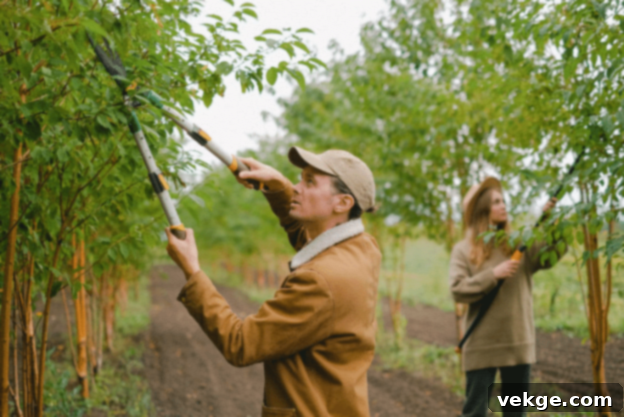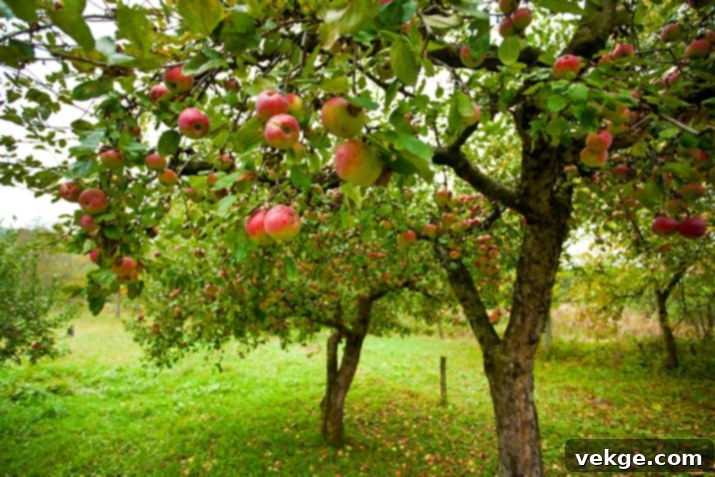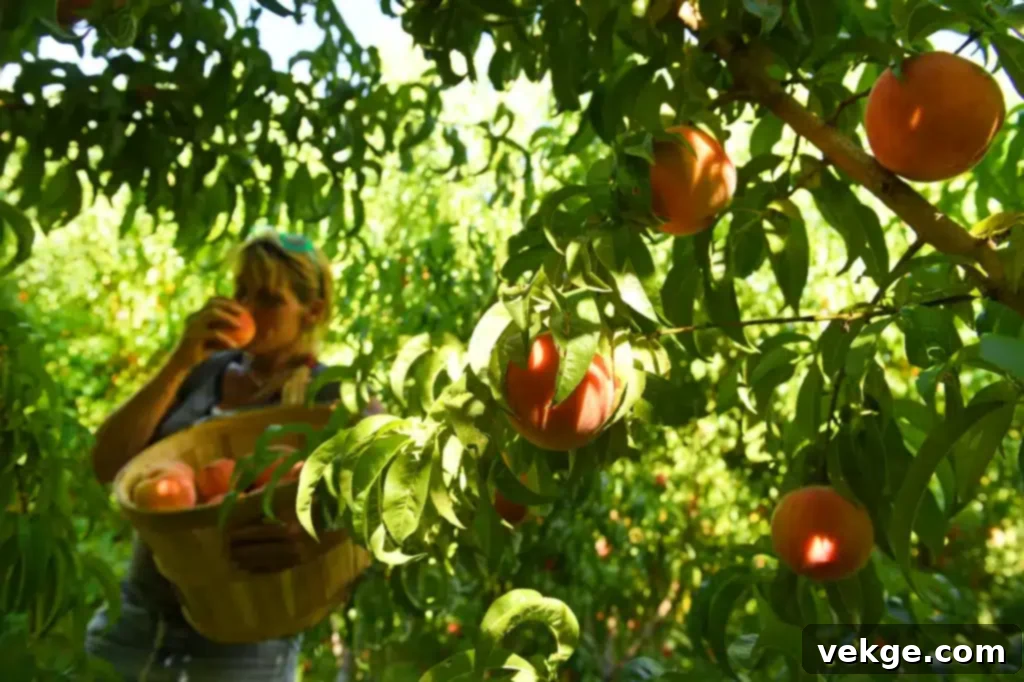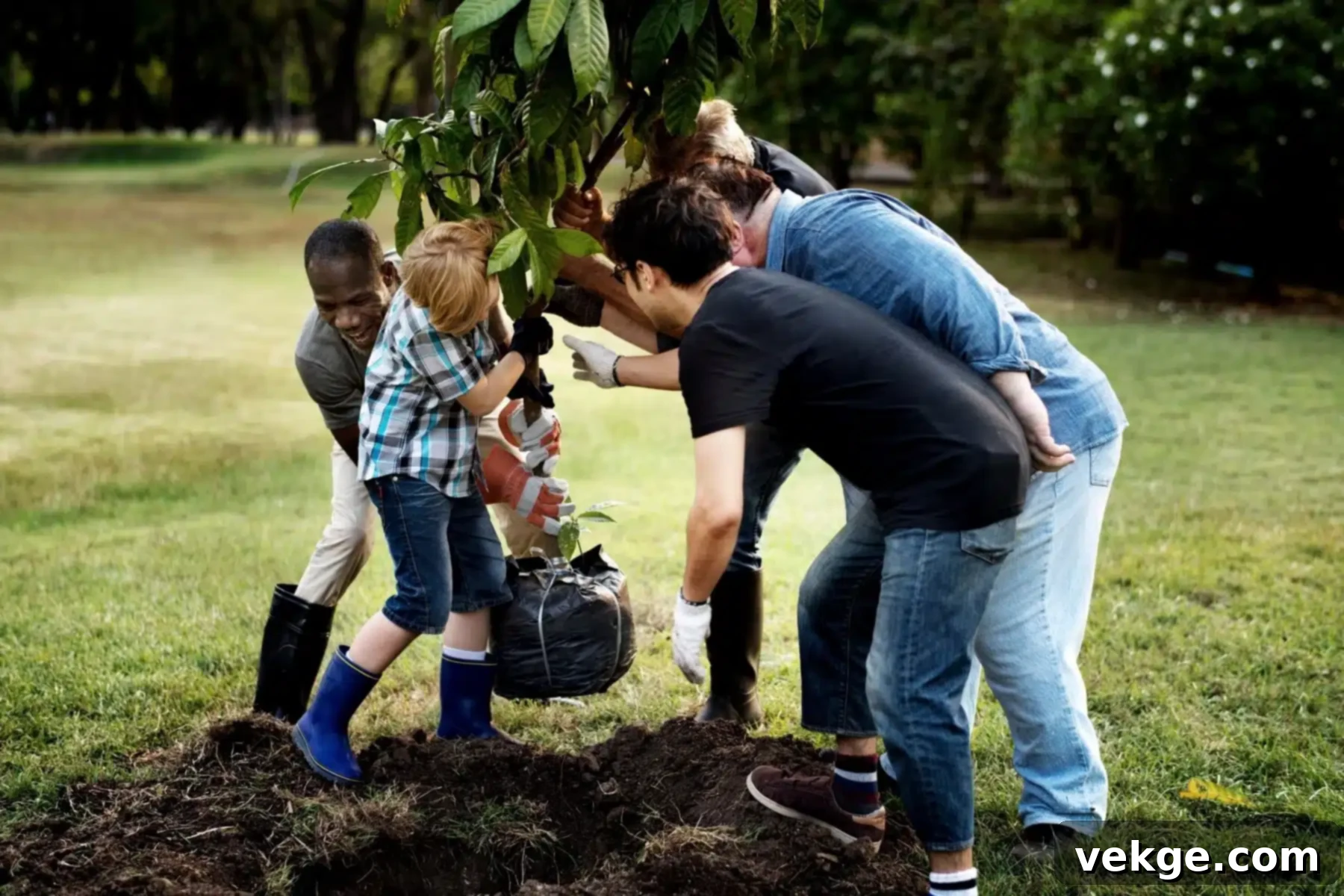The Ultimate Guide to Planting and Caring for Fruit Trees in Your Home Garden
Imagine stepping into your backyard and plucking a ripe, juicy apple or a sweet, succulent plum directly from your very own tree. There’s a profound satisfaction that comes from nurturing something from a tiny sapling into a vibrant, fruit-bearing plant. Growing fruit trees in your home garden offers more than just aesthetic appeal; it provides a continuous supply of delicious, nutritious, and organic fruits for years to come, connecting you deeply with nature’s bounty.
This comprehensive guide draws upon years of personal experience and horticultural knowledge, sharing a step-by-step journey from the initial dream of an orchard to the joyous moment of harvest. We’ll cover every essential aspect you need to know, ensuring your fruit tree endeavor is a resounding success. From selecting the perfect tree to understanding its unique needs throughout the growing season, prepare to cultivate a thriving home orchard that will reward you generously.
Choosing the Right Fruit Tree for Your Garden
 The journey to a flourishing fruit garden begins with a critical decision: selecting the right tree. This isn’t just about picking your favorite fruit; it involves understanding what varieties will thrive in your specific environment and meet your expectations. When I embarked on my fruit tree venture, I initially focused on plum trees, captivated by their diverse flavors and characteristics. I carefully researched varieties known for their sweet and juicy plums, ensuring they would be a rewarding addition to my garden.
The journey to a flourishing fruit garden begins with a critical decision: selecting the right tree. This isn’t just about picking your favorite fruit; it involves understanding what varieties will thrive in your specific environment and meet your expectations. When I embarked on my fruit tree venture, I initially focused on plum trees, captivated by their diverse flavors and characteristics. I carefully researched varieties known for their sweet and juicy plums, ensuring they would be a rewarding addition to my garden.
Beyond personal preference, consider the vast array of fruit trees available. Apples, pears, peaches, cherries, figs, and citrus fruits each come with numerous cultivars, offering different tastes, textures, disease resistance, and ripening times. Researching these options will help you make an informed choice that aligns with your goals, whether it’s for fresh eating, baking, or preserving.
Consider Climate and Soil Conditions in Your Area
Before making any purchase, it is paramount to evaluate your local climate and existing soil conditions. These two factors are arguably the most significant determinants of a fruit tree’s success. Every tree variety has specific requirements for chilling hours (the number of hours below a certain temperature during winter dormancy), hardiness zones (USDA or equivalent), and tolerance to heat or cold.
For my plum trees, I meticulously cross-referenced varieties with my region’s hardiness zone and average chilling hours. Planting a tree that isn’t suited to your climate will inevitably lead to disappointment. Additionally, assess the size of your garden. Fruit trees, even dwarf varieties, require adequate space for healthy root development and canopy growth. Ensure the fruit trees you select will have sufficient room to spread without overcrowding, allowing for proper air circulation and sunlight exposure.
Preparing the Soil: The Foundation for Success
Proper soil preparation is the cornerstone of a healthy and productive fruit tree. Think of it as laying a robust foundation for a house; without it, the structure will struggle. Your fruit trees need a welcoming environment to establish strong roots and absorb essential nutrients. Begin by choosing an optimal planting site—one that receives at least 6-8 hours of direct sunlight daily and boasts excellent drainage. Fruit trees despise “wet feet,” so avoid areas where water tends to collect or heavy clay soils that retain too much moisture, as these conditions are notorious for causing root rot and other detrimental issues as your trees grow.
Remove Debris and Loosen the Soil
Once you’ve identified the perfect spot for your new fruit trees, it’s time for hands-on soil preparation. Start by thoroughly clearing the area of any unwanted debris. This includes sticks, large rocks, stubborn weeds, grass, or any other obstructions that could hinder root growth. After clearing, proceed to loosen the soil to a depth of at least 12 to 18 inches. A sturdy shovel or a garden fork will be your best tools for this task. As you work, be mindful not to damage any existing desirable roots from nearby plants or trees, should there be any.
Loosening the soil improves aeration, allowing oxygen to reach the roots, and enhances water penetration. It also makes it easier for the tree’s roots to spread out and establish themselves in their new home, reducing transplant shock and promoting vigorous early growth.
Enrich the Soil with Organic Matter
To significantly boost soil fertility and structure, the next crucial step is to incorporate ample organic matter. Well-decomposed compost, aged manure, or other organic soil amendments are ideal. These materials improve soil texture, increase its water-holding capacity in sandy soils, enhance drainage in clay soils, and, most importantly, provide a slow-release source of vital nutrients for your growing trees.
Aim for a generous ratio, roughly one-third organic amendment to two-thirds existing soil. Spread the compost or manure evenly over the loosened area and then thoroughly mix it into the top 12-18 inches of soil. Take the time to break up any large clumps to ensure an even distribution, creating a rich, friable planting medium that your fruit trees will love.
Test the Soil pH
The pH level of your soil plays a critical role in nutrient availability. Most fruit trees thrive in slightly acidic to neutral soils, typically with a pH range between 6.0 and 7.0. Outside this optimal range, even if nutrients are present, the tree may struggle to absorb them. To accurately determine your soil’s current pH, it’s highly recommended to perform a soil test. You can easily purchase a reliable soil test kit from your local garden center, or for a more detailed analysis, send soil samples to a professional testing laboratory.
Understanding your soil’s pH is key to making informed amendments. If your soil is too acidic, you might need to add agricultural lime. If it’s too alkaline, incorporating elemental sulfur or organic matter like peat moss can help lower the pH. Always follow the specific recommendations based on your soil test results to avoid over-correcting.
Correcting Nutrient Deficiencies for Optimal Growth
 One of the most proactive and important steps in ensuring your newly planted fruit trees have the best possible start is to understand and correct any existing soil nutrient deficiencies. A soil test, as mentioned earlier, is invaluable here. It provides a precise snapshot of which essential nutrients are present in adequate amounts and, crucially, which ones are missing or in short supply. This knowledge empowers you to tailor your soil amendments, providing exactly what your fruit trees need to grow strong, healthy, and productive from day one.
One of the most proactive and important steps in ensuring your newly planted fruit trees have the best possible start is to understand and correct any existing soil nutrient deficiencies. A soil test, as mentioned earlier, is invaluable here. It provides a precise snapshot of which essential nutrients are present in adequate amounts and, crucially, which ones are missing or in short supply. This knowledge empowers you to tailor your soil amendments, providing exactly what your fruit trees need to grow strong, healthy, and productive from day one.
Utilize a Soil Testing Kit for Accurate Analysis
Acquiring a reliable soil testing kit from your local garden center is a wise investment. These kits typically provide crucial information about the primary macronutrients such as nitrogen (N), phosphorus (P), and potassium (K), often referred to as NPK, which are vital for overall plant health. Some advanced kits or professional lab analyses will also identify micronutrients like iron, manganese, zinc, and boron, which are needed in smaller quantities but are equally essential for fruit development and disease resistance.
A professional soil analysis report will not only show you the current nutrient levels but will often include specific recommendations for how to amend your soil based on the type of plants you intend to grow. This detailed insight prevents guesswork and ensures you’re providing a balanced nutritional foundation.
Strategically Add Missing Nutrients to Your Soil
Once you’ve identified the specific nutrients your soil is lacking, you can proceed with targeted amendments. This often involves incorporating fertilizers or organic matter rich in the identified deficient nutrients. For example, if your soil test reveals a nitrogen deficiency, you might add a nitrogen-rich fertilizer like blood meal or alfalfa meal, or incorporate well-rotted chicken manure. If phosphorus is low, bone meal is an excellent organic option, while wood ash or greensand can boost potassium levels.
It’s vital to remember that “too much of a good thing” can be detrimental. Over-fertilization can burn roots, lead to excessive leafy growth at the expense of fruit, or cause nutrient imbalances. Always follow the instructions on fertilizer packaging carefully, applying the recommended amounts. I personally lean towards incorporating organic fertilizers into my fruit tree care routine. Organic options, such as compost or slow-release granular organic fertilizers, release nutrients gradually over time, fostering a healthier soil microbiome and improving the soil’s overall structure and long-term fertility, rather than just providing a quick chemical boost.
Planting Your Fruit Trees: A Step-by-Step Guide
 With the perfect tree selected and the soil meticulously prepared, the exciting moment of planting your fruit tree has arrived. Proper planting technique is crucial for giving your tree the best possible start and ensuring its long-term health and productivity.
With the perfect tree selected and the soil meticulously prepared, the exciting moment of planting your fruit tree has arrived. Proper planting technique is crucial for giving your tree the best possible start and ensuring its long-term health and productivity.
Start by digging a planting hole that is twice as wide as the tree’s root ball and deep enough so that the tree’s root collar (where the trunk meets the roots) will be level with or slightly above the surrounding soil surface. This is particularly important for grafted trees, where the graft union must remain several inches above the soil line to prevent the scion from rooting and losing the benefits of the rootstock.
Gently remove the tree from its container or unwrap its burlap. Inspect the root ball; if the roots are circling tightly or matted, carefully loosen them with your fingers or a small hand rake. Prune away any broken, diseased, or unusually long roots. Place the tree in the center of the prepared hole, ensuring it stands straight. Begin backfilling the hole with the amended soil you prepared earlier, gently tamping it down as you go to eliminate air pockets. Air pockets can dry out roots and hinder establishment.
Once the hole is filled, create a small soil berm or basin around the planting area, just outside the root ball. This will help retain water and direct it down to the roots. Finally, water the tree thoroughly immediately after planting. This helps settle the soil around the roots and provides essential hydration to mitigate transplant shock. For taller trees or those in windy locations, consider staking for the first year to provide support until the root system is firmly established.
Caring for Your Fruit Tree: Nurturing Growth and Harvest
Planting is just the beginning; the ongoing care you provide will determine the health, vigor, and fruit production of your trees. Fruit trees are living investments that require consistent attention to thrive. Here are the key aspects of fruit tree care you’ll need to master:
Watering: The Elixir of Life
Adequate and consistent watering is paramount for young fruit trees, especially during their first year of growth when their root systems are still developing. Aim to water deeply once a week, or more frequently during hot, dry spells. The goal is to soak the entire root zone, encouraging roots to grow deeper into the soil rather than remaining near the surface. To check if your tree needs water, feel the soil about an inch or two down; if it’s dry, it’s time to water. Signs of under-watering include wilting leaves, while over-watering can lead to yellowing leaves and root rot. Applying a layer of organic mulch (like wood chips or straw) around the base of the tree (keeping it a few inches away from the trunk) will help retain soil moisture, suppress weeds, and regulate soil temperature, significantly reducing your watering efforts.
Fertilizing: Feeding for Future Fruits
As your fruit trees mature, they will require supplemental nutrients to support healthy growth and abundant fruit production. A balanced fertilizer, typically applied in early spring before new growth emerges and potentially again in late fall after harvest, is generally recommended. The exact type and amount will depend on your soil test results and the specific needs of your tree. Young trees benefit from nitrogen for leafy growth, while fruiting trees require more phosphorus and potassium for flower and fruit development. Organic options, like compost tea or granular organic fertilizers, provide a steady release of nutrients and enhance soil health over time. Always observe your tree for signs of nutrient deficiency (e.g., yellowing leaves, stunted growth) or excess, and adjust your fertilization schedule accordingly.
Pruning: Shaping for Success and Productivity
Pruning is an art and a science essential for maintaining the health, shape, and productivity of your fruit trees. Regular pruning helps promote strong structural branches, improves air circulation within the canopy (reducing disease risk), and directs the tree’s energy into fruit production rather than excessive vegetative growth. There are different types of pruning, including structural pruning for young trees, maintenance pruning for mature trees, and corrective pruning to remove dead or diseased wood.
The ideal time to prune most fruit trees is in late winter or early spring, before new growth appears. This allows you to easily see the tree’s structure and minimizes stress. Always use sharp, clean pruning tools to make clean cuts, and educate yourself on the specific pruning techniques for your type of fruit tree, as requirements can vary significantly.
Pest and Disease Control: Protecting Your Harvest
Fruit trees can unfortunately be susceptible to various pests and diseases that can damage foliage, fruit, and even the tree itself. Vigilance is key. Regularly inspect your trees for any signs of damage or infestation, such as chewed leaves, unusual spots, sticky residue, or visible insects. Early detection allows for prompt and often less invasive treatment.
Embrace an integrated pest management (IPM) approach, which prioritizes preventative measures and organic solutions before resorting to chemical interventions. This includes ensuring good air circulation through pruning, maintaining tree vigor through proper nutrition and watering, and encouraging beneficial insects. If pests or diseases do arise, research the specific issue and choose the most environmentally friendly and effective treatment, whether it’s an organic spray, biological control, or in severe cases, a targeted chemical application.
Winter Protection: Guarding Against the Cold
For fruit trees in colder climates, providing winter protection can be critical. This might involve wrapping young tree trunks to prevent sunscald and rodent damage, mulching heavily around the base to insulate roots, or even covering tender varieties during severe cold snaps. Understanding your tree’s hardiness zone and preparing for winter conditions will help ensure its survival through the dormant season.
Harvesting Your Fruit: The Sweet Reward
After months of diligent care and patient waiting, the moment arrives to reap the delicious rewards of your labor: harvesting your fruit. There’s truly nothing quite like the taste of a fresh, organic fruit picked straight from your own garden. Knowing exactly when to harvest is crucial, as ripeness varies significantly among different fruit types.
 Many common fruit trees, such as apples and pears, typically ripen on the tree. However, some varieties can be harvested slightly before full ripeness and allowed to finish ripening indoors, which can extend their storage life. Peaches, plums, and cherries are generally best picked when fully ripe and soft to the touch, as they don’t improve much in sweetness after being removed from the tree.
Many common fruit trees, such as apples and pears, typically ripen on the tree. However, some varieties can be harvested slightly before full ripeness and allowed to finish ripening indoors, which can extend their storage life. Peaches, plums, and cherries are generally best picked when fully ripe and soft to the touch, as they don’t improve much in sweetness after being removed from the tree.
To determine ripeness, look for changes in color, check for a slight give when gently squeezed, and, most importantly, taste! A ripe fruit will usually detach easily from the branch with a gentle twist or pull. Handle your fruit with care to avoid bruising, which can quickly lead to spoilage. Once harvested, store your fruit in a cool, dry place, or refrigerate as appropriate for the specific fruit type, until you are ready to enjoy their exquisite taste. The abundance of a successful harvest is not only a feast for your palate but also a profound connection to the cycles of nature in your own backyard.
Planting and Caring For Fruit Trees: Conclusion
Embarking on the journey of planting and caring for fruit trees in your home garden is an incredibly rewarding endeavor. It’s a wonderful way to infuse both beauty and functionality into your outdoor space, transforming it into a personal oasis of fresh produce. Beyond the undeniable pleasure of enjoying tree-ripened, organic fruit picked mere steps from your door, your fruit trees will also contribute to your home’s ecosystem by providing valuable shade, improving air quality, and offering a habitat for local wildlife.
With the comprehensive knowledge and practical tips shared in this guide, you are now well-equipped to cultivate healthy, productive fruit trees that will generously provide an annual bounty for many years to come. Remember that successful fruit tree cultivation is a blend of careful planning, consistent attention, and a little patience. Each season brings new observations and learning opportunities, making the process itself as fulfilling as the harvest.
To ensure your success, always remember these key steps: start by choosing the right tree variety that is perfectly suited to your local climate and garden space. Meticulously prepare the soil, ensuring it has optimal drainage, fertility, and pH. Plant your chosen tree properly, setting it up for robust root establishment. Finally, commit to ongoing care, including regular and appropriate watering, timely fertilization, strategic pruning, and vigilant pest and disease control. By following these guidelines, you’ll be on your way to harvesting an abundance of healthy, juicy, and utterly delicious fruits straight from your very own backyard orchard.
